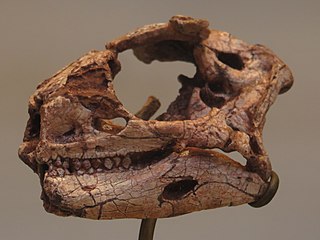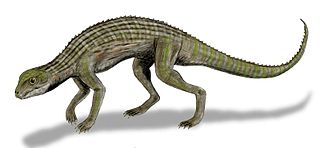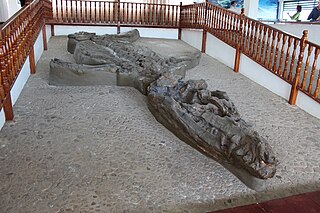
Lesothosaurus is a monospecific genus of ornithischian dinosaur that lived during the Early Jurassic in what is now South Africa and Lesotho. It was named by paleontologist Peter Galton in 1978, the name meaning "lizard from Lesotho". The genus has only one valid species, Lesothosaurus diagnosticus. Lesothosaurus is one of the most completely-known early ornithischians, based on numerous skull and postcranial fossils from the Upper Elliot Formation. It had a simpler tooth and jaw anatomy than later ornithischians, and may have been omnivorous in some parts of the year.

Rhynchosaurs are a group of extinct herbivorous Triassic archosauromorph reptiles, belonging to the order Rhynchosauria. Members of the group are distinguished by their triangular skulls and elongated, beak like premaxillary bones. Rhynchosaurs first appeared in the Early Triassic, reaching their broadest abundance and a global distribution during the Carnian stage of the Late Triassic.

Hyperodapedon is an extinct genus of rhynchosaur reptiles which lived during Late Triassic period. Like other rhynchosaurs, it was an heavily built archosauromorph, distantly related to archosaurs such as crocodilians and dinosaurs. Hyperodapedon in particular was part of the subfamily Hyperodapedontinae, a specialized rhynchosaurian subgroup with broad skulls, beaked snouts, and crushing tooth plates on the roof of the mouth.

Tasmaniosaurus is an extinct genus of archosauromorph reptile known from the Knocklofty Formation of West Hobart, Tasmania, Australia. The type species is T. triassicus. This genus is notable not only due to being one of the most complete Australian Triassic reptiles known, but also due to being a very close relative of Archosauriformes. Once believed to be a proterosuchid, this taxon is now believed to have been intermediate between advanced non-archosauriform archosauromorphs such as Prolacerta, and basal archosauriforms such as Proterosuchus. Features traditionally used to define Archosauria and later Archosauriformes, such as the presence of an antorbital fenestra and serrated teeth, are now known to have evolved prior to those groups due to their presence in Tasmaniosaurus.

Adamantinasuchus is an extinct genus of notosuchian crocodylomorph from and named after the Late Cretaceous Adamantina Formation of Brazil. It is known from only one fossil, holotype UFRJ-DG 107-R, collected by William Nava. The fossil consists of a partial skull, fragmentary limb bones and a few broken vertebrae, and was found 25 kilometres (16 mi) southwest of the town of Marilia, near a reservoir dam. Adamantinasuchus was approximately 60 centimetres (24 in) long from nose to tail, and would have only weighed a few kilograms.

Thalattosaurus meaning "sea lizard," from the Attic Greek thalatta (θάλαττα), "sea," and sauros (σαῦρος), "lizard," is an extinct genus of marine reptile in the family Thalattosauroidea. They were aquatic diapsids that are known exclusively from the Triassic period. It was a 2–3 metres (6.6–9.8 ft) long shellfish-eating reptile with paddle-like limbs and a down-turned rostrum occurring in the Lower and Middle Triassic Sulphur Mountain Formation of British Columbia as well as the Upper Triassic Hosselkus Limestone of California. It has gained notoriety as a result of studies on general diapsid phylogeny.

Biseridens is an extinct genus of anomodont therapsid, and one of the most basal anomodont genera known. Originally known from a partial skull misidentified as an eotitanosuchian in 1997, another well-preserved skull was found in the Qingtoushan Formation in the Qilian Mountains of Gansu, China, in 2009 that clarified its relationships to anomodonts, such as the dicynodonts.

Peirosaurus is an extinct genus of peirosaurid crocodylomorph known from the Late Cretaceous period of Minas Gerais, southern Brazil. It contains a single species, Peirosaurus torminni. It is the type genus of the family Peirosauridae.

Yonghesuchus is an extinct genus of Late Triassic archosaur reptile. Remains have been found from the early Late Triassic Tongchuan Formation in Shanxi, China. It is named after Yonghe County, the county where fossils were found. Currently only one species, Y. sangbiensis, is known. The specific name refers to Sangbi Creek, as fossils were found in one of its banks.

Stenaulorhynchus is an extinct genus of hyperodapedontid rhynchosaur known from the Middle Triassic deposits of Tanganyika Territory, Tanzania. It was found in the Lifua Member of the Manda Formation in the Karoo Supergroup. It was named and first described by Sidney Henry Haughton in 1932. The type species is Stenaulorhynchus stockleyi, a beaked herbivore measuring 1–6 meters in length.

Campinasuchus is an extinct genus of baurusuchid mesoeucrocodylian from Minas Gerais State of Brazil.

Jesairosaurus is an extinct genus of early archosauromorph reptile known from the Illizi Province of Algeria. It is known from a single species, Jesairosaurus lehmani. Although a potential relative of the long-necked tanystropheids, this lightly-built reptile could instead be characterized by its relatively short neck as well as various skull features.

Noteosuchus is an extinct genus of basal rhynchosaur known from the earliest Triassic deposits of Eastern Cape Province, South Africa. It was first named by David Meredith Seares Watson in 1912 and the type species is Eosuchus colletti. The generic name Eosuchus is preoccupied by the generic name of Eosuchus lerichei Dollo, 1907, a gavialoid crocodilian known from northern France. Thus, an alternative generic name, Noteosuchus, was proposed by Robert Broom in 1925. The generic name erected by Broom (1925) is a compound, meaning "Not Eosuchus", while "Eosuchus" is derived from the name of Eos, the goddess of the dawn in Greek mythology, and suchus, Latinized from the Greek souchos, an Egyptian crocodile god, thus meaning "dawn crocodile". The specific name, colletti, honors Mr. Collett for the discovery of the holotype and only known specimen.
Panguraptor is a genus of coelophysid theropod dinosaur known from fossils discovered in Lower Jurassic rocks of southern China. The type and only known species is Panguraptor lufengensis. The generic name refers to the deity Pangu but also to the supercontinent Pangaea for which in a geological context the same characters are used: 盘古. Raptor means "seizer", "robber" in Latin. The specific name is a reference to the Lufeng Formation. The holotype specimen was recovered on 12 October 2007 from the Lufeng Formation of Yunnan, which is noted for sauropodomorph fossils. It was described in 2014 by You Hai-Lu and colleagues.
Eohyosaurus is an extinct genus of basal rhynchosaur known from the early Middle Triassic Burgersdorp Formation of Free State, South Africa. It contains a single species, Eohyosaurus wolvaardti.
Fraxinisaura is an extinct genus of basal lepidosauromorph reptile known from the Middle Triassic of Germany. The only known species is Fraxinisaura rozynekae. It possessed an elongated snout, unique features of the teeth, and an ilium which was intermediate in orientation between sphenodontians and squamates. Based on characteristics of the maxilla, it is considered a close relative of Marmoretta from the Middle Jurassic of the United Kingdom, resolving a ghost lineage between that genus and other Triassic basal lepidosauromorphs.

Gnathovorax is a genus of herrerasaurid saurischian dinosaur from the Santa Maria Formation in Rio Grande do Sul, Brazil. The type and only species is Gnathovorax cabreirai, described by Pacheco et al. in 2019.

Polymorphodon is an extinct genus of archosauriform reptile from the Middle Triassic of Germany. The only known species is Polymorphodon adorfi, discovered in Lower Keuper deposits at a quarry in Eschenau, Germany. Polymorphodon is notable for its heterodont dentition, with long and conical premaxillary teeth followed by thin maxillary teeth with large serrations. Maxillary teeth near the back of the mouth are short and leaf-shaped, similar to some living and extinct reptiles with a herbivorous or omnivorous diet. This may suggest that Polymorphodon had some reliance on plants in its diet, a rarity among basal archosauriforms, most of which are carnivores.
Barrosasuchus is a genus of peirosaurid notosuchian from the Santonian of Argentina and part of the extensive peirosaurid record of Late Cretaceous Patagonia. It contains one species, Barrosasuchus neuquenianus. B. neuquenianus is known from an almost complete skull and the majority of the articulated postcranial skeleton, making it the best preserved Patagonian peirosaurid.

Monquirasaurus is an extinct genus of giant short-necked pliosaurs who lived during the Early Cretaceous (Aptian) in what is now Colombia. One species is known, M. boyacensis, described in 2021 from an almost complete fossil skeleton, discovered in 1977 in the town of Villa de Leyva, located in Boyacá. Published descriptions of the holotype specimen estimate that it should reach a total size approaching 8 m (26 ft) in length, making Monquirasaurus a large representative of the pliosaurids.
















